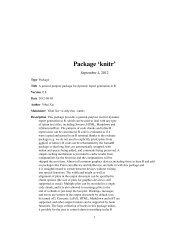Package 'openair'
Package 'openair'
Package 'openair'
Create successful ePaper yourself
Turn your PDF publications into a flip-book with our unique Google optimized e-Paper software.
142 windRosews.intThe Wind speed interval. Default is 2 m/s but for low met masts with low meanwind speeds a value of 1 or 0.5 m/s may be better. Note, this argument is supersededin pollutionRose. See breaks below.angle Default angle of “spokes” is 30. Other potentially useful angles are 45 and 10.Note that the width of the wind speed interval may need adjusting using width.typecolsgrid.linewidthsegauto.textbreaksoffsetpaddletype determines how the data are split i.e. conditioned, and then plotted. Thedefault is will produce a single plot using the entire data. Type can be one ofthe built-in types as detailed in cutData e.g. “season”, “year”, “weekday” andso on. For example, type = "season" will produce four plots — one for eachseason.It is also possible to choose type as another variable in the data frame. If thatvariable is numeric, then the data will be split into four quantiles (if possible)and labelled accordingly. If type is an existing character or factor variable, thenthose categories/levels will be used directly. This offers great flexibility for understandingthe variation of different variables and how they depend on oneanother.Type can be up length two e.g. type = c("season", "weekday") will producea 2x2 plot split by season and day of the week. Note, when two types areprovided the first forms the columns and the second the rows.Colours to be used for plotting. Options include “default”, “increment”, “heat”,“jet”, “hue” and user defined. For user defined the user can supply a list ofcolour names recognised by R (type colours() to see the full list). An examplewould be cols = c("yellow", "green", "blue", "black").Grid line interval to use. If NULL, as in default, this is assigned by windRosebased on the available data range. However, it can also be forced to a specificvalue, e.g. grid.line = 10.For paddle = TRUE, the adjustment factor for width of wind speed intervals.For example, width = 1.5 will make the paddle width 1.5 times wider.For pollutionRose seg determines with width of the segments. For example,seg = 0.5 will produce segments 0.5 * angle.Either TRUE (default) or FALSE. If TRUE titles and axis labels will automaticallytry and format pollutant names and units properly e.g. by subscripting the ‘2’ inNO2.Most commonly, the number of break points for wind speed in windRose orpollutant in pollutionRose. For windRose and the ws.int default of 2 m/s,the default, 4, generates the break points 2, 4, 6, 8 m/s. For pollutionRose, thedefault, 6, attempts to breaks the supplied data at approximately 6 sensible breakpoints. However, breaks can also be used to set specific break points. For example,the argument breaks = c(1, 10, 100) breaks the data into segments100.The size of the ’hole’ in the middle of the plot, expressed as a percentage of thepolar axis scale, default 10.Either TRUE (default) or FALSE. If TRUE plots rose using ‘paddle’ style spokes. IfFALSE plots rose using ‘wedge’ style spokes.
















